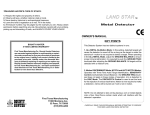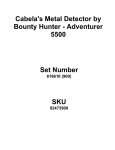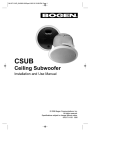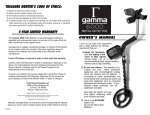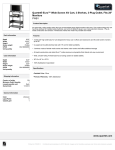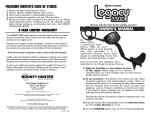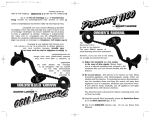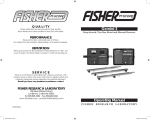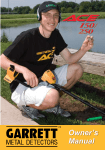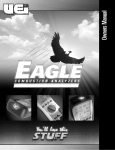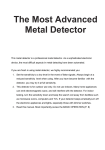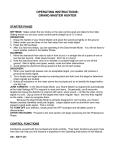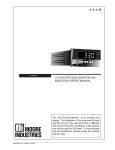Download Titan Tool 2000XD User's Manual
Transcript
Owner’s Manual TABLE!OF!CONTENTS Assembly . . . . . . . . . . . . . . . . . . . . . . . . . . . . . . . . .3-4 Batteries . . . . . . . . . . . . . . . . . . . . . . . . . . . . . . . . . . .5 Quick-Start Demo . . . . . . . . . . . . . . . . . . . . . . . . . .6-7 Basic Operation . . . . . . . . . . . . . . . . . . . . . . . . . . .8-11 All Metal . . . . . . . . . . . . . . . . . . . . . . . . . . . . . . .9 Discrimination . . . . . . . . . . . . . . . . . . . . . . . . . .10 Notch . . . . . . . . . . . . . . . . . . . . . . . . . . . . . . . .10 ITD . . . . . . . . . . . . . . . . . . . . . . . . . . . . . . . . . .11 Audio Target Identification . . . . . . . . . . . . . . . . . . . .12 Target and Depth Display . . . . . . . . . . . . . . . . . . . . .13 Sensitivity Adjustment . . . . . . . . . . . . . . . . . . . . . . .14 In The Field Techniques . . . . . . . . . . . . . . . . . . . .15-17 Trouble Shooting . . . . . . . . . . . . . . . . . . . . . . . . . . .18 Terminology . . . . . . . . . . . . . . . . . . . . . . . . . . . . . . .19 Treasure Hunter’s Code of Ethics . . . . . . . .Back Cover Warranty . . . . . . . . . . . . . . . . . . . . . . . . . . .Back Cover 2 ASSEMBLY Assembly is easy and requires no tools. 1 Position the lower stem (the straight tube) ● with the silver button toward the back. Using the bolt and knurled knob, attach the search coil to the plastic extension protruding from the lower stem. 2 P ress ● the button on the upper end of the lower stem, and slide the lower stem into the upper stem. Adjust the stem to a length that lets you maintain a comfortable upright posture, with your arm relaxed at your side, and the search coil parallel to the ground in front of you. 3 Wind ● the cable securely around the stem. 4 I n s e rt ● the plug into the matching connector on the right underside of the detector body. Be sure that the key-way and pins line up correctly. Caution: Do not force the plug in. Excess force will cause damage. To disconnect the cable, pull on the plug. Do not pull on the cable. 3 ASSEMBLY 4 BATTERIES Use ALKALINE batteries only. To install the batteries: 1 Remove ● the battery cover by disengaging the clip at the back. 2 Align the polarity ● of the batteries correctly, with the positive "+" toward the coil plug connection, as indicated by the + and – indicators on the housing. 3 Insert ● (2) 9-Volt ALKALINE batteries, with the contacts pointed inward, and press down on the back of the batteries to snap them into place. Some brands of batteries will re q u i re moderate force to clear the retaining tabs. IN CASE OF LOOSE BATTERIES If the batteries fit loosely, and you want to guarantee a very secure electrical contact, insert a piece of paper or thin cardboard between the back of the battery and the supporting post. 4 Replace the battery door. ● The Low Battery Indicator will come on and stay on if the batteries need to be replaced. Most metal detector problems are due to improperly installed batteries, or the use of non-alkaline or discharged batteries. If the detector does not turn on, please check the batteries. If the detector does not turn on, check to see that the batteries fit tightly. If the batteries are loose, press them forward while pressing the ON touchpad. To tighten up a loose battery, wedge a piece of paper or thin cardboard between the back of the battery and the supporting post, as illustrated above. 5 QUICK-START!DEMONSTRATION I. Supplies Needed • A Nail • A Pull-Tab from a beverage can • A Quarter • A Zinc Penny (dated after 1982) II. Position the Detector a. Place the detector on a table, with the search coil hanging over the edge. (or better, have a friend hold the detector, with the coil off the ground) b. Keep the search coil away from walls, floors, and metal objects. c. Remove watches, rings and other jewelry or metal objects from hands and wrists. d. Turn off appliances or lights that cause electromagnetic interference. e. Pivot search coil back toward the detector body. III. Power Up Press the POWER touchpad. IV. Wave each Object over the Search Coil a. Notice a different tone for each object. Base Tone: Nail Low Tone: Pull-tab Medium Tone: Zinc Penny High Tone: Quarter b. Motion is required. Objects must be in motion over the search coil to be detected. V. Press the DISC/ALL METAL touchpad(*) The detector will beep twice and “R” will appear under the iron indicator. Quick-Start Demo continued on next page 6 QUICK-START!DEMONSTRATION!(continued) VI. Wave the Nail over the Search Coil a. The Nail will not be detected. b. The Nail has been "Discriminated Out." VII. P ress the “DISCRIMINAT I O N -▲” Three “R”s are now displayed. VIII. Wave all objects over the Search Coil The Nail and Pull-Tab will not be detected. The other objects will be detected with their own distinctive tones. IX. Press the NOTCH touchpad. A flashing “R” will appear under the 5¢/PT segment. X. Press the DISCRIMINATION ▲ touchpad three times. The flashing “R” will move to the ZINC segment. XI. Press the NOTCH touchpad again. The “R” will appear under zinc. XII. Wave the zinc penny over the search coil. The penny is discriminated out. XIII. Press the DISC ALL-METAL touchpad The detector returns to ALL-METAL mode. No “R”s are displayed. All types of metals will be detected. XIV. Wave the pull-tab over the coil. XV. Press the ITD touchpad. An “R” will appear. XVI. Wave the pull-tab over the search coil again. The pull-tab (the most recently detected item) is eliminated from detector. 7 BASIC!OPERATION! POWERING UP Press the POWER touch pad. • The detector will beep 4 times • All display segments will illuminate momentarily • The SENSITIVITY and BATTERY indicators will stay illuminated SENSITIVITY The detector’s default sensitivity will be indicated with two segments. At this setting, the detector will detect a coin-sized object, such as a quarter, buried approximately seven inches deep. To change the sensitivity level, and thus the detection depth, press the SENSITIVITY ▲ or ▼ keys. CAUTION: At higher sensitivity levels, the detector is susceptible to electromagnetic interference from electronic devices. Reduce sensitivity if demonstrating indoors or if using near power lines or electrical equipment. Reduce sensitivity if detector emits false signals 8 BASIC!OPERATION!(continued) DEFAULT OPERATION The detector defaults to ALL METAL mode after powering on. In this mode, all types of metals will be detected. An object’s probable identification is indicated by the arrows at the top of the display. In addition, the probable depth of coin-sized objects is indicated by the large numeric indicator in the center of the display. All detected objects will cause the depth indicator to illuminate. The depth indication is not accurate for larger objects; however, it will provide accurate relative depth indications. The greater the distance an object is from the search coil, the greater its depth value. DISC/ ALL-METAL Touch Pad P ressing this touch pad will cause the detector to toggle between two operating modes, DISCRIMINATION and ALLMETAL. If the detector is in the ALL-METAL mode (the default mode), pressing the touch pad will change the detector into DISCRIMINATION mode. If the detector is in the DISCRIMINATION mode, p ressing the touch pad will change the detector into ALLMETAL mode. DISCRIMINATION MODE Discrimination is used to eliminate unwanted objects from detection. To enter this mode, from ALL-METAL mode, press the DISC/ALL-METAL touch pad. After pressing DISC/ALL-METAL, the detector will: • Beep twice • Display an "R" under the left-most segment, Iron Ferrous objects will not be detected in DISCRIMINATION mode. Heavily oxidized ferrous objects will sometimes, however, be detected, usually with a high tone and an indication to the right of the target identification scale. 9 BASIC!OPERATION!(continued) To increase the level of discrimination, press the DISCRIMINATION ▲ touch pad. Each time the ▲ pad is depressed, an additional "R" will appear, thus eliminating from detection the objects which fall into the corresponding categories. To decrease the level of discrimination, press the DISCRIMINATION ▼ touch pad. Each time the ▼ pad is depressed, an illuminated "R" will disappear, thus returning to detection the objects which fall into the corresponding categories. Discrimination Mode is a fixed-start-point elimination system. Objects are cumulatively eliminated as the level of discrimination increases. NOTCH MODE To selectively eliminate a category from detection within the metallic spectrum, use the NOTCH Mode. Technical Note: The NOTCH touch pad causes the status of an "R" segment to toggle between ON and OFF. To use the NOTCH Mode: The NOTCH touch pad can be depressed at any time. But for first-time use, place the detector in ALL-METAL mode. A first demonstration is best accomplished as follows: 1) Turn the power OFF. 2) Turn the power ON. 3) Press NOTCH. A flashing "R" will appear under the IRON segment. 4) Press the DISCRIMINATION ▲ touch pad several times Notice that the "R" moves upon each press of the DISCRIMINATION ▲ touch pad. 5) Press NOTCH again. The flashing "R" will become permanently illuminated. If an object has been “notched-out”, you can return it to detection status. To “un-notch” a category: 1) Press NOTCH. 2) Move the flashing “R” over the permanently illuminated “R”. 3) Press NOTCH again. 10 BASIC OPERATION (continued) ITD The ITD control is a convenient way to eliminate a known undesirable metal object from detection. To demonstrate the ITD control: 1) Set the detector in All-Metal Mode Note: ITD functions in all modes, but is best demonstrated first from the All-Metal Mode. 2) Pass the search coil over an undesirable object. 3) Notice the Target Indication Note: You can only ITD objects that register under the five left-most segments (from Iron to Zinc). 4) Press ITD. An "R" appears under the segment to be eliminated. 5) Pass the search coil over the same object again. The undesirable object is eliminated from detection The ITD control is easy to use in the field. As you are detecting, and encounter an object which you wish to eliminate from detection, simply press the ITD touch pad after detecting the object. The ITD control eliminates the most-recently detected object category from detection. The category eliminated is indicated with an "R". HEADPHONE JACK Using headphones (not supplied) with your metal detector makes it easier to identify subtle changes in the threshold levels for better detection results, and also reduces drain on the batteries. The Titan 2000 XD Metal Detector has a stereo headphone jack located at the rear of the case. This device is to be used with interconnecting cables/headphone cables shorter than three meters. 11 AUDIO!TARGET!IDENTIFICATION While the LCD (Liquid Crystal Display) is very accurate in identifying buried objects, the user in the field does not always maintain the display screen in his field of vision. Therefore, we have incorporated an audio feedback mechanism to alert the user to the nature of buried objects. This audio feedback system first alerts the user to the presence and classification of objects, whose nature and location can be confirmed using the LCD display. The detector can sound four different tones, depending on the object detected. BASS TONE Ferrous objects, such as iron and steel, will induce a bass tone. The smallest gold objects can also induce a bass tone. LOW TONE Pull-Tabs, nickels & smaller gold MEDIUM TONE Newer pennies (post-1982), larger gold objects, zinc, small brass objects, and most bottle screw caps will induce medium tones. Many recent vintage foreign curre n c i e s will induce medium tones. HIGH TONE Silver and copper coins, larger brass objects, older pennies (pre1982), and highly oxidized metals will induce high tones. Quarters, dimes and other precious coins fall into this category. 12 BASS TONE Nails, Iron Objects, & Smallest Gold Objects LOW TONE Pull Tabs, Nickels, & Smaller Gold MEDIUM TONE Zinc US Pennies (Post 1982), Larger Gold Objects, Many Screw Caps. HIGH TONE Copper, Silver & Brass Copper Pennies (Pre 1982) Audio Target Identification (ATI) classifies metals into three categories. TARGET!AND!DEPTH!DISPLAY READING THE DISPLAY The Liquid Crystal Display (LCD) shows the PROBABLE identification of the t a rgeted metal, as well as the PROBABLE depth of the target, in inches. The detector will register a repeated, unchanging target identification when a buried target has been located and identified. If, upon repeated passes over the same spot, the target identification reads inconsistently, the target is probably a trash item, or oxidized metal. Wi t h practice, you will learn to unearth only the repeatable signals. The segment identifications are highly accurate, when detecting the objects described on the label. However, if you register in a given category for an unknown buried object, you could be detecting a metallic object other than the object described on the label, but with the same metallic signature. Also, the greater the distance between the target and the coil, the less accurate the target identification. GOLD TARGETS Gold objects will register on the left side of the LCD scale. Gold flakes will register under Iron/Foil Small gold items will register under PT. Medium-sized gold items will register under S-cap. L a rge gold items will register under Zinc. SILVER TARGETS: Silver objects will register to the right of the scale, under 25¢, 50¢, or $1, depending on the size of the object. The larger the object, the farther to the right it will register. IRON/FOIL: All sizes of iron and aluminum objects will register on the far-left side of the scale. This could indicate a worthless item such as a nail, or a more valuable historic iron relic. PT (pull tab): All older pull tabs fro m beverage cans will register here. Some newer pull tabs will register here. Many gold rings will also register here . S-CAP: Older screw caps from glass bottles will register here. Large gold rings, like a class ring, could also register here . Some non-U.S. coins of recent vintage will also register here. ZINC: Newer pennies (post-1982) will register here. Many non-U.S. coins of recent vintage will also register here . 10¢: Dimes and pre-1982 pennies will register here. Older, pre-1982, pennies are composed of copper, which has a metallic s i g n a t u resimilar to a dime. CAUTION: The target indications are visual re f e rences. Many other types of metal can fall under any one of these categories. While the Titan 2000 XD will eliminate or indicate the presence of most common trash items, it is impossible to accurately classify ALL buried objects. DEPTH INDICATOR: The Depth Indicator is accurate for coinsized objects. It indicates the depth of the t a rget, in inches. Large and irregularlyshaped objects will yield less reliable depth readings When passing over an object, the depth indicator will light up and stay illuminated until another object is scanned. Repeated indication at the same depth level indicates an accurate target detector. If the depth indication varies with each sweep, try sweeping at diff e rent angles; there may be more than one target present. Wi t h practice, you will learn the diff e re n c e between accurate readings, multiple t a rgets, and highly erratic readings which evidence trash or irregularly shaped objects. 13 SENSITIVITY!ADJUSTMENT ELECTROMAGNETIC INTERFERENCE The principle use for the Sensitivity C o n t rol is to eliminate Electromagnetic Interference (EMI). A hobby metal detector is an extremely sensitive device; the search coil creates its own magnetic field and acts like an antenna. If your detector beeps erratically when the search coil is motionless, the unit is probably detecting another electromagnetic field. Common sources of EMI are electric power lines, both suspended and buried, motors, and household appliances like computers and microwave ovens. Some indoor electronic devices, such as dimmer switches used on household lighting, produce severe EMI and can cause the detector to beep erratically. Other metal detectors also produce their own electromagnetic fields; so if detecting with a friend, keep two metal detectors at least 20 feet apart. If the detector beeps erratically, REDUCE THE SENSITIVITY by pressing the Sensitivity ▼ Pad on the left of the control panel. SEVERE GROUND CONDITIONS A secondary use for the Sensitivity Control is to reduce false detection signals caused by severe ground conditions. While your Titan 2000 XD contains circuitry to eliminate the signals caused by most naturally occurring ground minerals, 100% of all ground conditions cannot be anticipated. Highly magnetic soils found in mountainous and gold-prospecting locations can cause the detector to emit tones when metal objects are not present. High saline content soils and sands can sometimes cause the detector to false. If the detector emits false, non-repeatable, signals, REDUCE THE SENSITIVITY. MULTIPLE TARGETS If you suspect the presence of deeper targets beneath a shallower target, reduce the sensitivity to eliminate the detection of the deeper targets, in order to properly locate and identify the shallower target. 14 IN!THE!FIELD!TECHNIQUES PINPOINTING COIL MOVEMENT Accurate pinpointing takes practice and is best accomplished by “X-ing” the target area. When swinging the coil, be careful to keep it level with the ground about one inch from the surface. Never swing the coil like a pendulum. 1. Once a buried target is indicated by a good tone response, continue sweeping the coil over the target in a narrowing sideto-side pattern. 2. Take visual note of the place on the ground where the “beep” sounds. 3. Stop the coil directly over this spot on the ground. 4. Now move the coil straight forward and straight back towards you a couple of times. 5. Again make visual note of the spot on the ground at which the “beep” sounds. 6. If needed, “X” the target at different angles to “zero in” on the exact spot on the ground at which the “beep” sounds. WRONG CORRECT When pinpointing a target, try drawing an “X”, as illustrated, over where the tone is induced. NOTE: This modern Metal Detector is referred to as a Motion Detector since it can respond to a target only while the searchcoil is being moved over the Target 15 IN!THE!FIELD!TECHNIQUES!(continued) Swing the search coil slowly, overlapping each sweep as you move forward. It is important to sweep the coil at a consistent speed over the ground as you search. After identifying a target, your sweep technique can help in identifying both the location and the nature of the target. If you encounter a weak signal, try moving the coil in short, rapid sweeps over the target zone; such a short rapid sweep may WHAT READS LIKE THIS 16 p rovide a more consistent targ e t identification. Most worthwhile objects will respond with a repeatable tone. If the signal does not repeat after sweeping the coil directly over the suspected target a few times, it is more than likely trash metal. C rossing the target zone with multiple intersecting sweeps at multiple angles is another way to verify the repeatability of the signal, and the potential of the buried target. To use this method, walk around the target area in a circle, sweeping the coil across the target repeatedly, every 30 to 40 degrees of the circle, about ten different angles as you walk completely around the target. If a high-tone target completely disappears from detection at a given angle, chances are that you are detecting oxidized ferrous metals, rather than a silver or copper object. If the tone changes a different angles, you many have encountered multiple objects. If you are new to the hobby, …MAY ACTUALLY BE THIS IN!THE!FIELD!TECHNIQUES!(continued) you may want to dig all targets at first. With practice in the field, you will learn to better discern the nature of buried objects by the nature of the detector’s response. You may encounter some false signals as you proceed. False signals occur when the detector beeps, but no metal target is present. False signals can be induced by e l e c t romagnetic interference, oxidation, or highly mineralized ground soils. If the detector beeps once, but does not repeat the signal with several additional sweeps over the same spot, there is probably no target present. surprised just how much trash metal and foil you will find in some areas. The trashiest areas have been frequented by the most people, and frequently hold the most promise for finding the most lost valuables. Also maintain the search coil positioned just above the surface of the ground, without making contact with the ground. Making contact with the ground can cause false signals. When searching very trashing ground, it is best to scan small areas with slow, short sweeps. You will be 17 TROUBLESHOOTING TROUBLE SHOOTING GUIDE SYMPTOM CAUSE SOLUTION Detector chatters or beeps erratically • Using detector indoors • Using detector near power lines • Using 2 detectors in close proximity • Highly oxidized buried object • Use detector outdoors only • Move away from power lines • Keep 2 detectors at least 20’ apart • Only dig up repeatable signals • Reduce sensitivity until erratic signals cease • Environmental electromagnetic interference Constant low tone or constant repeating tones • Discharged batteries • Wrong type of batteries • Replace batteries • Use only 9V alkaline batteries, or fully c h a rged rechargeable LCD does not lock on to one target ID or detector emits multiple tones • Multiple targets present • Highly oxidized target • Sensitivity set too high • Move coil slowly at different angles No power, no sounds • Dead batteries • Poor battery contact • Cord not connected securely • Replace batteries • Push batteries in tighter •Insert paper spacers (see page 5) • Check connections 18 • Reduce sensitivity TERMINOLOGY The following terms are used throughout the manual, and are standard terminology among detectorists. ELIMINATION Reference to a metal being "eliminated" means that the detector will not emit a tone, nor light up an indicator, when a specified object passes through the coil’s detection field. DISCRIMINATION When the detector emits different tones for different types of metals, and when the detector "eliminates" certain metals, we refer to this as the detector "discriminating" among different types of metals. Discrimination is an important feature of professional metal detectors. Discrimination allows the user to ignore trash and otherwise undesirable objects. RELIC IRON A relic is an object of interest by reason of its age or its association with the past. Many relics are made of iron, but can also be made of bronze or precious metals. Iron is a common, low-grade metal that is an undesirable target in certain metal detecting applications. Examples of undesirable iron objects are old cans, pipes, bolts, and nails. Sometimes, the desired target is made of iron. Property markers, for instance, contain iron. Valuable relics can also be composed of iron; cannon balls, old armaments, and parts of old structures and vehicles can also be composed of iron. FERROUS Metals which are made of, or contain, iron. PINPOINTING Pinpointing is the process of finding the exact location of a buried object. Long-buried metals can appear exactly like the surrounding soil, and can therefore be very hard to isolate from the soil. PULL-TABS Discarded pull-tabs from beverage containers are the most bothersome trash items for treasure hunters. They come in many different shapes and sizes. Most pull-tabs can be eliminated with the Mode Control, but some other valuable objects can have a magnetic signature similar to pull-tabs, and will also be eliminated when discriminating out pull-tabs. GROUND BALANCE Ground Balancing is the ability of the detector to ignore, or "see through," the earth’s naturally occurring minerals, and only sound a tone when a metal object is detected. 19 TREASURE HUNTER’S CODE OF ETHICS: • Always check Federal, State, County and local laws before searching. • Respect private property and do not enter private property without the owner’s permission. • Take care to refill all holes and try not to leave any damage. • Remove and dispose of any and all trash and litter found. • Appreciate and protect our inheritance of natural resources, wildlife and private property. • Act as an ambassador for the hobby, use thoughtfulness, consideration and courtesy at all times. • Never destroy historical or archaeological treasures. • All treasure hunters may be judged by the example you set; always conduct yourself with courtesy and consideration of others First Texas Products, L.L.C. Five Year Limited Warranty Titan Metal Detectors are warranted against defects in workmanship or materials under normal use for five years from date of purchase to the original user. Liability in all events is limited to the purchase price paid. Liability under this WARRANTY is LIMITED to replacing or repairing, at our option, any Titan Detector returned, shipping cost prepaid, to First Texas Products, L.L.C. 1465-H Henry Brennan El Paso, Texas 79936 Damage due to neglect, accidental damage or misuse of this product is not covered by this warranty. Proof of purchase is required to make a claim under this warranty. NOTE TO FOREIGN COUNTRY CUSTOMERS This warranty may vary in other countries, check with your distributor for details. Factory warranty follows the channel of distribution. Warranty does not cover shipping costs. Copyright© 2009 by First Texas Products, L.L.C. All rights reserved, including the right to reproduce this book, or parts thereof, in any form. Published by First Texas Products, L.L.C.. Titan is made exclusively for Kellyco Metal Detector by First Texas Products, L.L.C. www.kellycodetectors.com METAL DETECTOR SUPERSTORE 1085 Belle Avenue, Winter Springs, FL 32708 (407) 699-8700 MTITAN2-071309




















